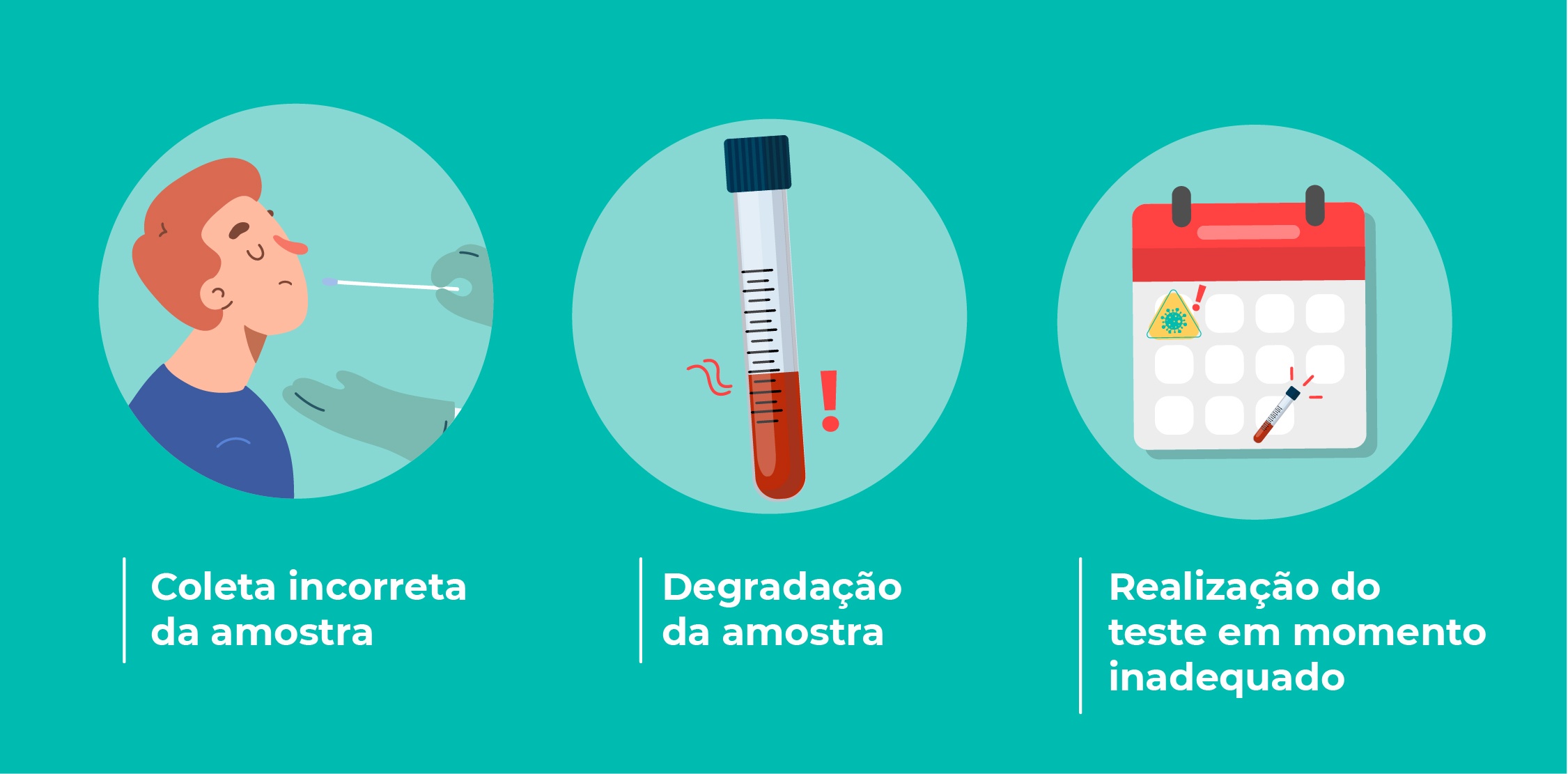O que é um falso negativo e o que causa esse resultado?
Hilab | 11 mar 2021

Os exames laboratoriais podem auxiliar na confirmação de diagnósticos e até mesmo monitorar a progressão de doenças e a eficiência de tratamentos.
Mas você já deve ter ouvido a história de alguém que testou negativo e depois descobriu que estava doente, não é mesmo?
Algumas vezes os testes podem sim apresentar resultados errôneos, como falsos positivos – quando o paciente não tem a doença mas o teste acusa que tem – e falsos negativos – quando o paciente tem a doença mas o resultado acusa que não tem.
Saiba mais sobre os falsos negativos no texto a seguir!
O que pode gerar um resultado falso negativo?
O resultado é considerado falso negativo quando o teste se mostra negativo, porém o paciente tem a doença.
Alguns fatores que podem gerar falsos negativos são coleta incorreta, degradação da amostra e realização do teste em momento inadequado.
Leia abaixo para saber mais:
1. Coleta incorreta da amostra
Um exemplo desse interferente é a coleta de swab de nariz e garganta para detecção do coronavírus. Por ser um procedimento invasivo e um pouco incômodo, o swab (o famoso “cotonete”) pode acabar não coletando nenhuma partícula viral. Dessa forma, o vírus não será detectado no exame, mesmo que a pessoa esteja infectada.
2. Degradação da amostra
É possível que durante o transporte da amostra para o laboratório, o microrganismo ou a substância que será analisada sejam degradados por condições externas, como por exemplo altas temperaturas ou armazenamento em recipiente inadequado.
3. Realização do teste em momento inadequado
Muitos exames detectam substâncias cuja concentração varia com o decorrer da doença ou da condição que está sendo investigada.
Um exemplo é o exame de gravidez, que detecta o hormônio Beta-hCG. No início da gravidez, a quantidade desse hormônio é tão baixa que os testes laboratoriais não conseguem detectá-lo. Por isso, se o exame é feito em menos de duas semanas após a fecundação, o resultado provavelmente será negativo.
Outros exemplos são os exames para detecção de material genético do coronavírus, como a PCR e o LAMP. Caso eles sejam realizados algumas semanas após a infecção, o resultado será negativo pois a carga viral diminui gradativamente ao longo dos dias. Por este motivo, estes testes devem ser feitos nos primeiros dias de infecção, e o inverso ocorre com os exames sorológicos.

Fatores que podem gerar resultados faso negativos nos exames.
Além disso, características próprias de cada teste também influenciam na geração de resultados falsos negativos, principalmente a sensibilidade do método. Entenda melhor:
- Sensibilidade: é a capacidade do teste positivar na presença da doença investigada. Quanto maior a sensibilidade, menor a chance de apresentar resultados falsos negativos, pois o teste consegue identificar mais facilmente a substância pretendida, mesmo que ela esteja em baixa quantidade.
- Especificidade: é a capacidade do teste negativar na ausência da doença investigada. Quanto maior a especificidade, menor a chance de apresentar resultados falsos positivos, porque o teste é capaz de detectar com exatidão a substância em questão, sem “confundi-la” com outras.
Como confiar nos resultados?
Com todos estes fatores envolvidos, você pode estar se perguntando se os exames laboratoriais são realmente confiáveis, não é?
Atualmente a maioria dos testes são desenvolvidos sob rigorosos processos de qualidade e validação para diminuir o máximo possível as chances de resultados falsos negativos e falsos positivos.
Além disso, a maior parte dos problemas nos resultados é decorrente de erros na fase pré-analítica (cerca de 70%!). Essa fase abrange as etapas de preparação do paciente e coleta da amostra, armazenamento e transporte da mesma. Por isso, é sempre bom perguntar ao médico ou ao laboratório se é necessário algum procedimento especial antes da coleta, como estar em jejum ou pausar alguma medicação antes da sua coleta.
E ainda, vale ressaltar: os exames laboratoriais são ferramentas importantíssimas, mas sozinhos não oferecem um diagnóstico definitivo. É necessário que, junto aos resultados, seu médico analise seu exame físico, histórico familiar e fatores de risco para chegar à interpretação correta, e assim decidir a conduta mais adequada para a sua situação.
Gostou do post? Assine a nossa newsletter e siga o @fazumhilab no Instagram para ver mais conteúdos sobre a sua saúde!
Manual MSD. Understanding medical tests and test results. Disponível em: <https://www.msdmanuals.com/professional/special-subjects/clinical-decision-making/understanding-medical-tests-and-test-results>. Acesso em: 12/02/2021.
PLEBANI, M. Errors in clinical laboratories or errors in laboratory medicine? Clinical Chemistry and Laboratory Medicine. Disponível em: <https://www.degruyter.com/document/doi/10.1515/CCLM.2006.123/html>. Acesso em: 12/02/2021.
STOJANOVIC, M. et al. Understanding sensitivity, specificity and predictive values. Military Medical and Pharmaceutical Journal of Serbia. Disponível em: <https://www.researchgate.net/publication/278871229_Understanding_sensitivity_specificity_and_predictive_values>. Acesso em: 12/02/2011.

Hilab
Somos especialistas em Point-of-Care Testing. Criamos dispositivos para exames PoCT, realizados com apenas algumas gotas de sangue e resultados entregues em poucos minutos. Nosso propósito é democratizar o acesso à saúde.

Deixe um comentário